Project Management Report
VerifiedAdded on 2020/02/03
|29
|9034
|34
Project
AI Summary
This comprehensive project management report assesses the viability of a gas production project for Cardial Oils and Gas. It utilizes various tools and techniques, including a PESTLE analysis (using British Petroleum as a benchmark), risk management strategies (force field analysis, RACI matrix, and 5 M's of management), and robust cost-benefit analysis (including ROI, payback period, and break-even analysis). The report also details project planning (project plan, scope, and SMART objectives), scheduling (WBS and Gantt chart), and project termination. The analysis concludes that entering the gas production industry presents a promising opportunity for Cardial to meet climate targets and enhance profitability.
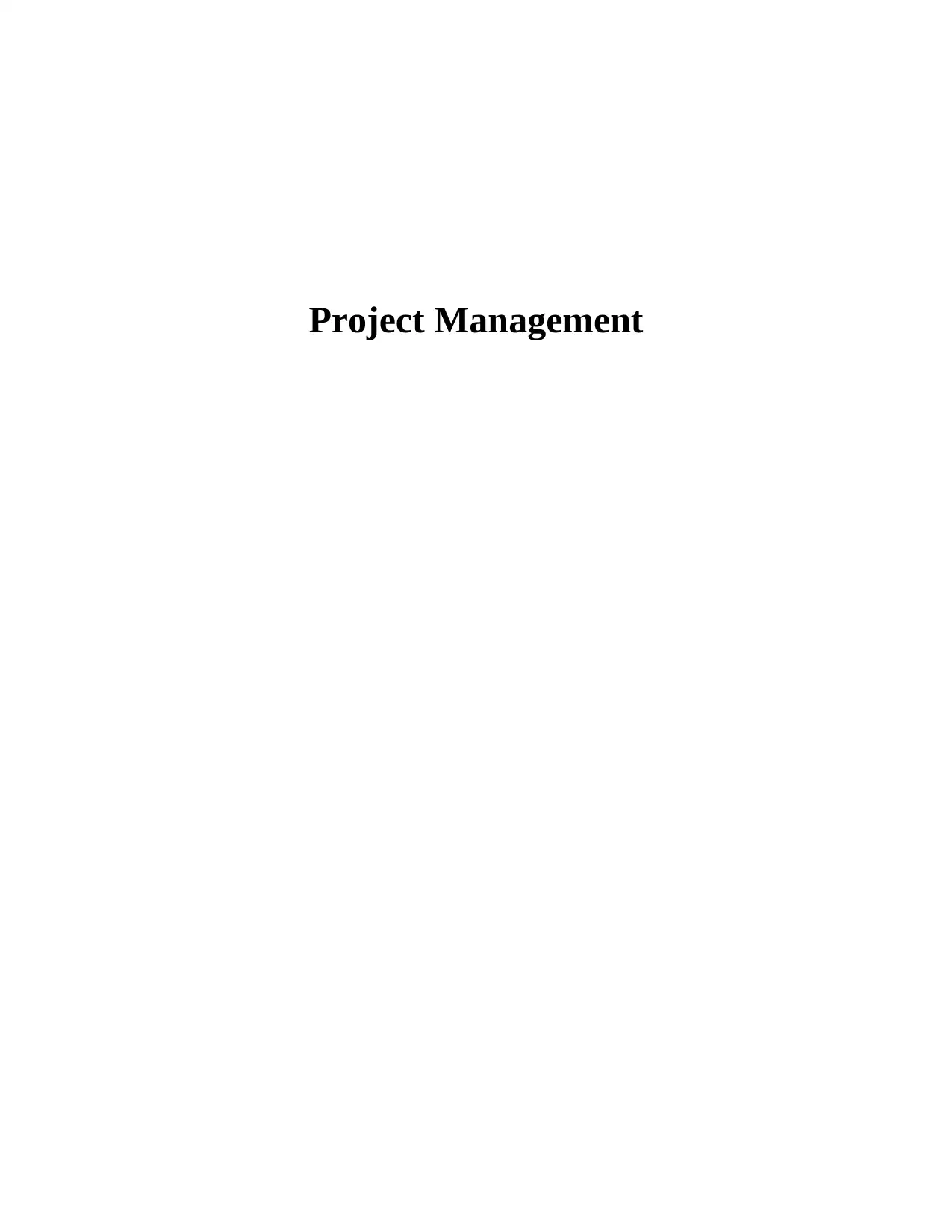
Project Management
Paraphrase This Document
Need a fresh take? Get an instant paraphrase of this document with our AI Paraphraser
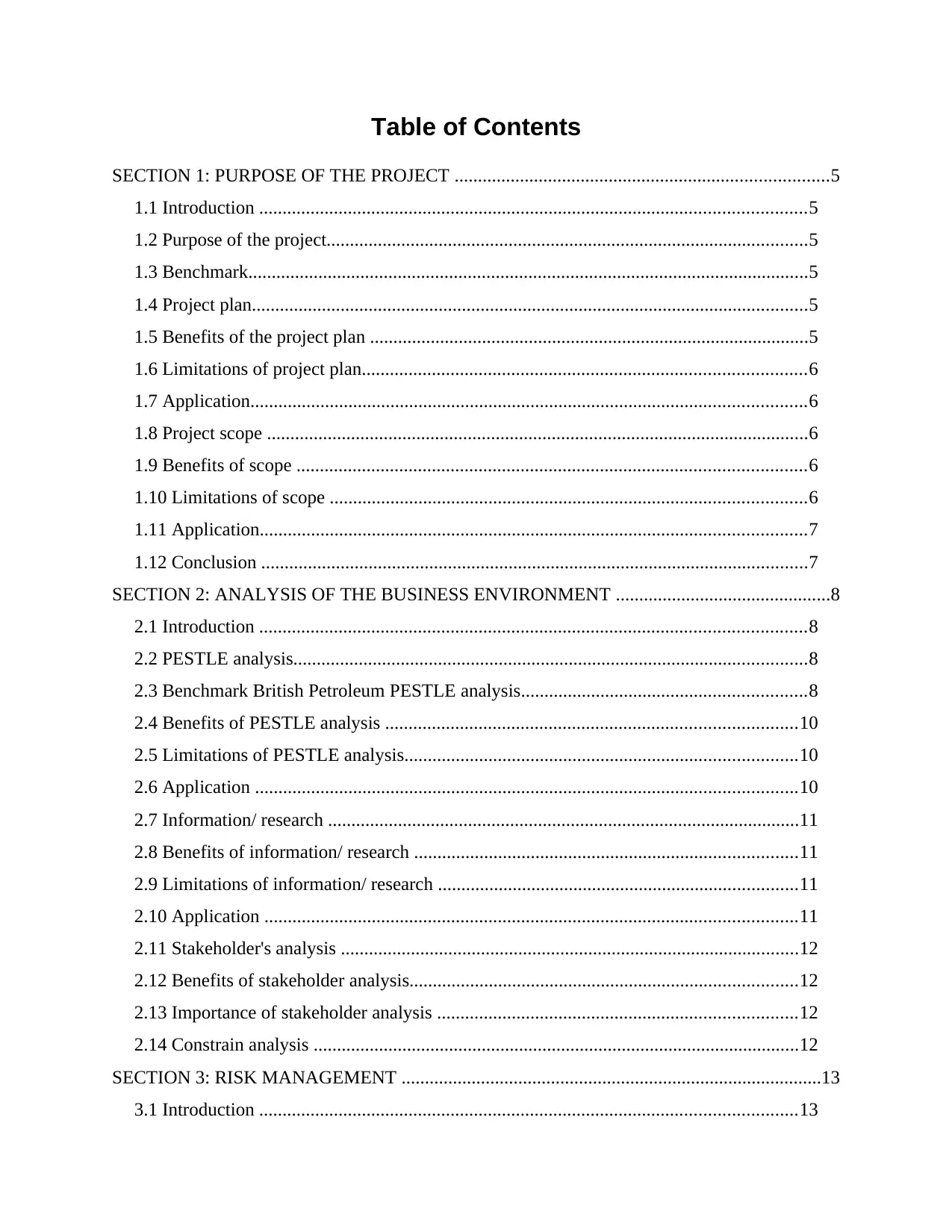
Table of Contents
SECTION 1: PURPOSE OF THE PROJECT ................................................................................5
1.1 Introduction .....................................................................................................................5
1.2 Purpose of the project.......................................................................................................5
1.3 Benchmark........................................................................................................................5
1.4 Project plan.......................................................................................................................5
1.5 Benefits of the project plan ..............................................................................................5
1.6 Limitations of project plan...............................................................................................6
1.7 Application.......................................................................................................................6
1.8 Project scope ....................................................................................................................6
1.9 Benefits of scope .............................................................................................................6
1.10 Limitations of scope ......................................................................................................6
1.11 Application.....................................................................................................................7
1.12 Conclusion .....................................................................................................................7
SECTION 2: ANALYSIS OF THE BUSINESS ENVIRONMENT ..............................................8
2.1 Introduction .....................................................................................................................8
2.2 PESTLE analysis..............................................................................................................8
2.3 Benchmark British Petroleum PESTLE analysis.............................................................8
2.4 Benefits of PESTLE analysis ........................................................................................10
2.5 Limitations of PESTLE analysis....................................................................................10
2.6 Application ....................................................................................................................10
2.7 Information/ research .....................................................................................................11
2.8 Benefits of information/ research ..................................................................................11
2.9 Limitations of information/ research .............................................................................11
2.10 Application ..................................................................................................................11
2.11 Stakeholder's analysis ..................................................................................................12
2.12 Benefits of stakeholder analysis...................................................................................12
2.13 Importance of stakeholder analysis .............................................................................12
2.14 Constrain analysis ........................................................................................................12
SECTION 3: RISK MANAGEMENT ..........................................................................................13
3.1 Introduction ...................................................................................................................13
SECTION 1: PURPOSE OF THE PROJECT ................................................................................5
1.1 Introduction .....................................................................................................................5
1.2 Purpose of the project.......................................................................................................5
1.3 Benchmark........................................................................................................................5
1.4 Project plan.......................................................................................................................5
1.5 Benefits of the project plan ..............................................................................................5
1.6 Limitations of project plan...............................................................................................6
1.7 Application.......................................................................................................................6
1.8 Project scope ....................................................................................................................6
1.9 Benefits of scope .............................................................................................................6
1.10 Limitations of scope ......................................................................................................6
1.11 Application.....................................................................................................................7
1.12 Conclusion .....................................................................................................................7
SECTION 2: ANALYSIS OF THE BUSINESS ENVIRONMENT ..............................................8
2.1 Introduction .....................................................................................................................8
2.2 PESTLE analysis..............................................................................................................8
2.3 Benchmark British Petroleum PESTLE analysis.............................................................8
2.4 Benefits of PESTLE analysis ........................................................................................10
2.5 Limitations of PESTLE analysis....................................................................................10
2.6 Application ....................................................................................................................10
2.7 Information/ research .....................................................................................................11
2.8 Benefits of information/ research ..................................................................................11
2.9 Limitations of information/ research .............................................................................11
2.10 Application ..................................................................................................................11
2.11 Stakeholder's analysis ..................................................................................................12
2.12 Benefits of stakeholder analysis...................................................................................12
2.13 Importance of stakeholder analysis .............................................................................12
2.14 Constrain analysis ........................................................................................................12
SECTION 3: RISK MANAGEMENT ..........................................................................................13
3.1 Introduction ...................................................................................................................13
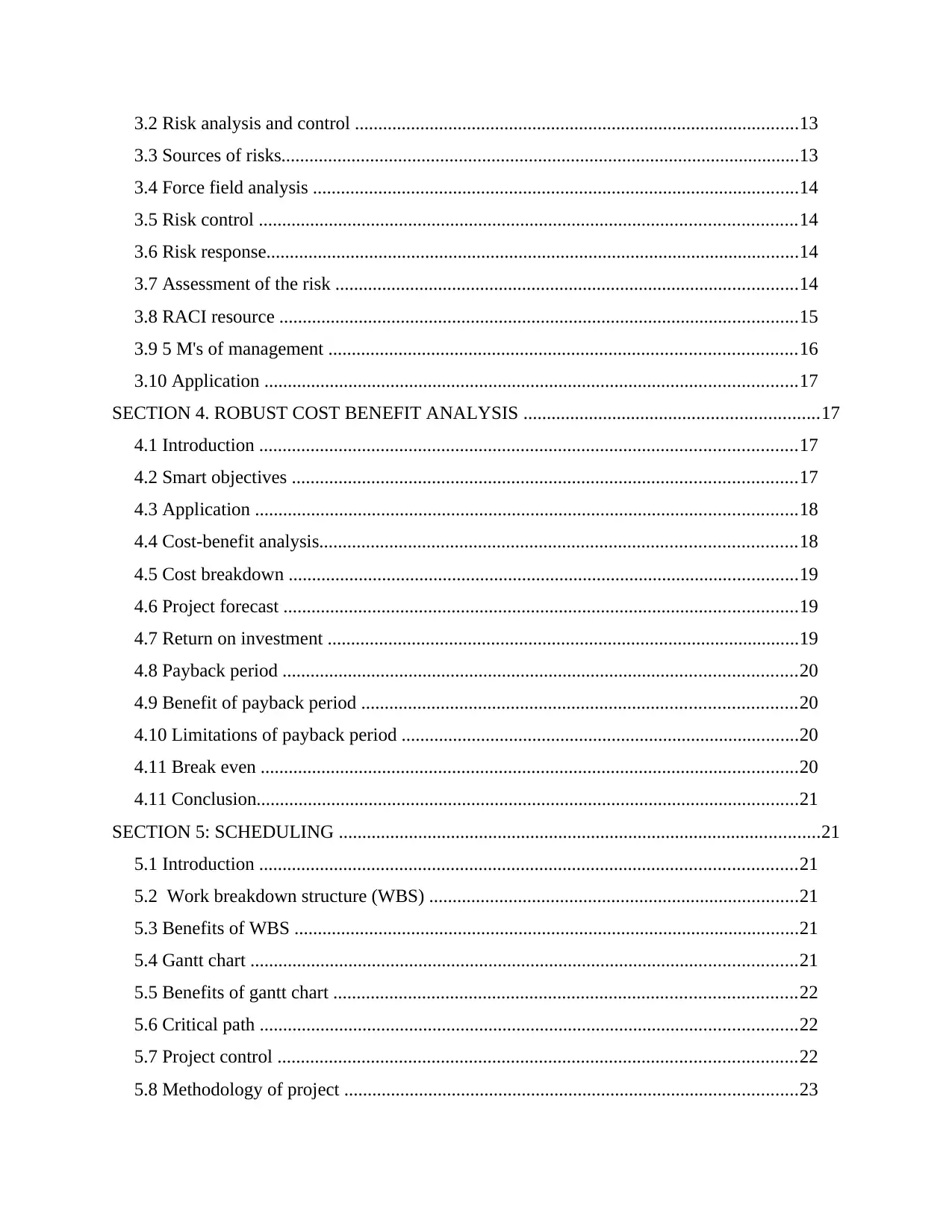
3.2 Risk analysis and control ...............................................................................................13
3.3 Sources of risks...............................................................................................................13
3.4 Force field analysis ........................................................................................................14
3.5 Risk control ...................................................................................................................14
3.6 Risk response..................................................................................................................14
3.7 Assessment of the risk ...................................................................................................14
3.8 RACI resource ...............................................................................................................15
3.9 5 M's of management ....................................................................................................16
3.10 Application ..................................................................................................................17
SECTION 4. ROBUST COST BENEFIT ANALYSIS ...............................................................17
4.1 Introduction ...................................................................................................................17
4.2 Smart objectives ............................................................................................................17
4.3 Application ....................................................................................................................18
4.4 Cost-benefit analysis......................................................................................................18
4.5 Cost breakdown .............................................................................................................19
4.6 Project forecast ..............................................................................................................19
4.7 Return on investment .....................................................................................................19
4.8 Payback period ..............................................................................................................20
4.9 Benefit of payback period .............................................................................................20
4.10 Limitations of payback period .....................................................................................20
4.11 Break even ...................................................................................................................20
4.11 Conclusion....................................................................................................................21
SECTION 5: SCHEDULING .......................................................................................................21
5.1 Introduction ...................................................................................................................21
5.2 Work breakdown structure (WBS) ...............................................................................21
5.3 Benefits of WBS ............................................................................................................21
5.4 Gantt chart .....................................................................................................................21
5.5 Benefits of gantt chart ...................................................................................................22
5.6 Critical path ...................................................................................................................22
5.7 Project control ...............................................................................................................22
5.8 Methodology of project .................................................................................................23
3.3 Sources of risks...............................................................................................................13
3.4 Force field analysis ........................................................................................................14
3.5 Risk control ...................................................................................................................14
3.6 Risk response..................................................................................................................14
3.7 Assessment of the risk ...................................................................................................14
3.8 RACI resource ...............................................................................................................15
3.9 5 M's of management ....................................................................................................16
3.10 Application ..................................................................................................................17
SECTION 4. ROBUST COST BENEFIT ANALYSIS ...............................................................17
4.1 Introduction ...................................................................................................................17
4.2 Smart objectives ............................................................................................................17
4.3 Application ....................................................................................................................18
4.4 Cost-benefit analysis......................................................................................................18
4.5 Cost breakdown .............................................................................................................19
4.6 Project forecast ..............................................................................................................19
4.7 Return on investment .....................................................................................................19
4.8 Payback period ..............................................................................................................20
4.9 Benefit of payback period .............................................................................................20
4.10 Limitations of payback period .....................................................................................20
4.11 Break even ...................................................................................................................20
4.11 Conclusion....................................................................................................................21
SECTION 5: SCHEDULING .......................................................................................................21
5.1 Introduction ...................................................................................................................21
5.2 Work breakdown structure (WBS) ...............................................................................21
5.3 Benefits of WBS ............................................................................................................21
5.4 Gantt chart .....................................................................................................................21
5.5 Benefits of gantt chart ...................................................................................................22
5.6 Critical path ...................................................................................................................22
5.7 Project control ...............................................................................................................22
5.8 Methodology of project .................................................................................................23
⊘ This is a preview!⊘
Do you want full access?
Subscribe today to unlock all pages.

Trusted by 1+ million students worldwide
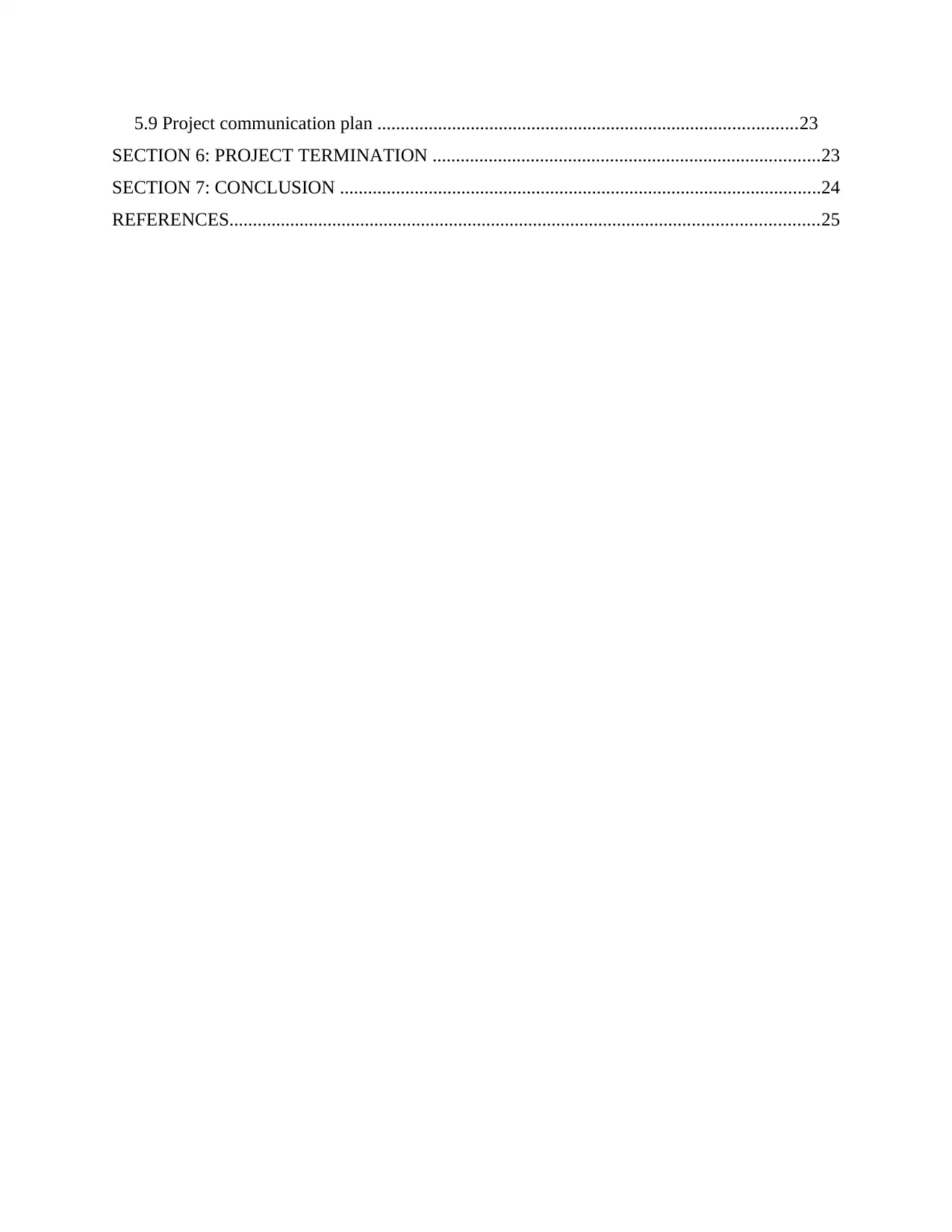
5.9 Project communication plan ..........................................................................................23
SECTION 6: PROJECT TERMINATION ...................................................................................23
SECTION 7: CONCLUSION .......................................................................................................24
REFERENCES..............................................................................................................................25
SECTION 6: PROJECT TERMINATION ...................................................................................23
SECTION 7: CONCLUSION .......................................................................................................24
REFERENCES..............................................................................................................................25
Paraphrase This Document
Need a fresh take? Get an instant paraphrase of this document with our AI Paraphraser
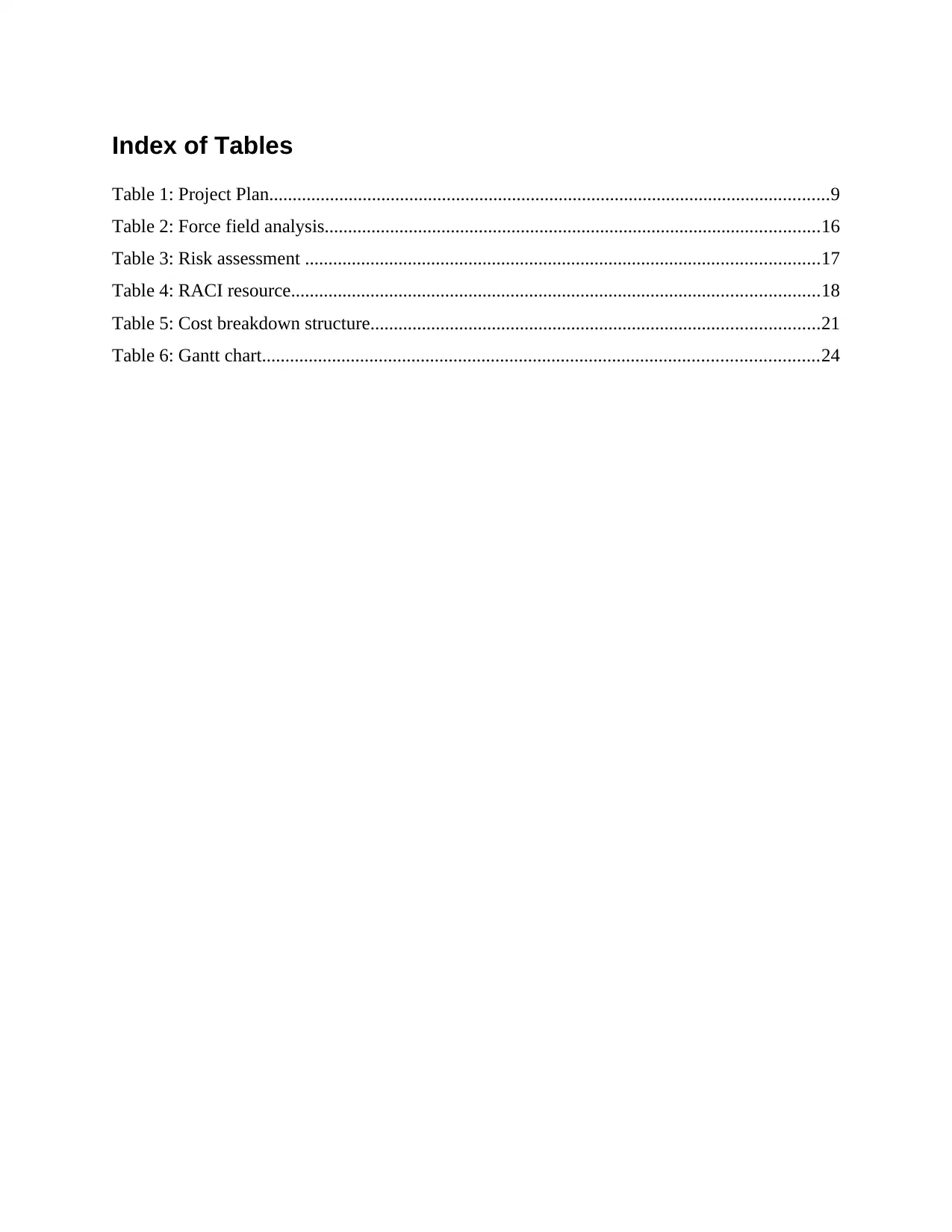
Index of Tables
Table 1: Project Plan........................................................................................................................9
Table 2: Force field analysis..........................................................................................................16
Table 3: Risk assessment ..............................................................................................................17
Table 4: RACI resource.................................................................................................................18
Table 5: Cost breakdown structure................................................................................................21
Table 6: Gantt chart.......................................................................................................................24
Table 1: Project Plan........................................................................................................................9
Table 2: Force field analysis..........................................................................................................16
Table 3: Risk assessment ..............................................................................................................17
Table 4: RACI resource.................................................................................................................18
Table 5: Cost breakdown structure................................................................................................21
Table 6: Gantt chart.......................................................................................................................24
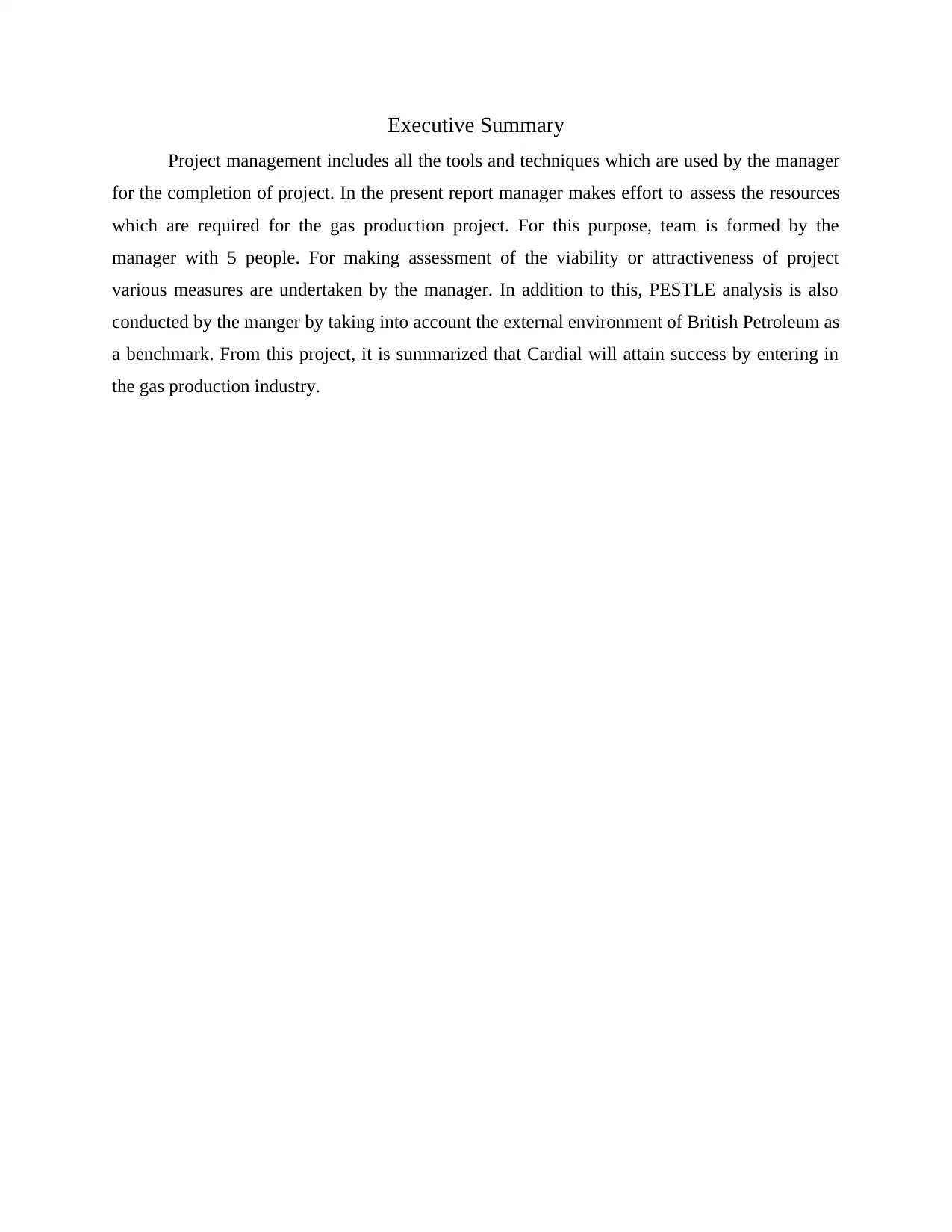
Executive Summary
Project management includes all the tools and techniques which are used by the manager
for the completion of project. In the present report manager makes effort to assess the resources
which are required for the gas production project. For this purpose, team is formed by the
manager with 5 people. For making assessment of the viability or attractiveness of project
various measures are undertaken by the manager. In addition to this, PESTLE analysis is also
conducted by the manger by taking into account the external environment of British Petroleum as
a benchmark. From this project, it is summarized that Cardial will attain success by entering in
the gas production industry.
Project management includes all the tools and techniques which are used by the manager
for the completion of project. In the present report manager makes effort to assess the resources
which are required for the gas production project. For this purpose, team is formed by the
manager with 5 people. For making assessment of the viability or attractiveness of project
various measures are undertaken by the manager. In addition to this, PESTLE analysis is also
conducted by the manger by taking into account the external environment of British Petroleum as
a benchmark. From this project, it is summarized that Cardial will attain success by entering in
the gas production industry.
⊘ This is a preview!⊘
Do you want full access?
Subscribe today to unlock all pages.

Trusted by 1+ million students worldwide
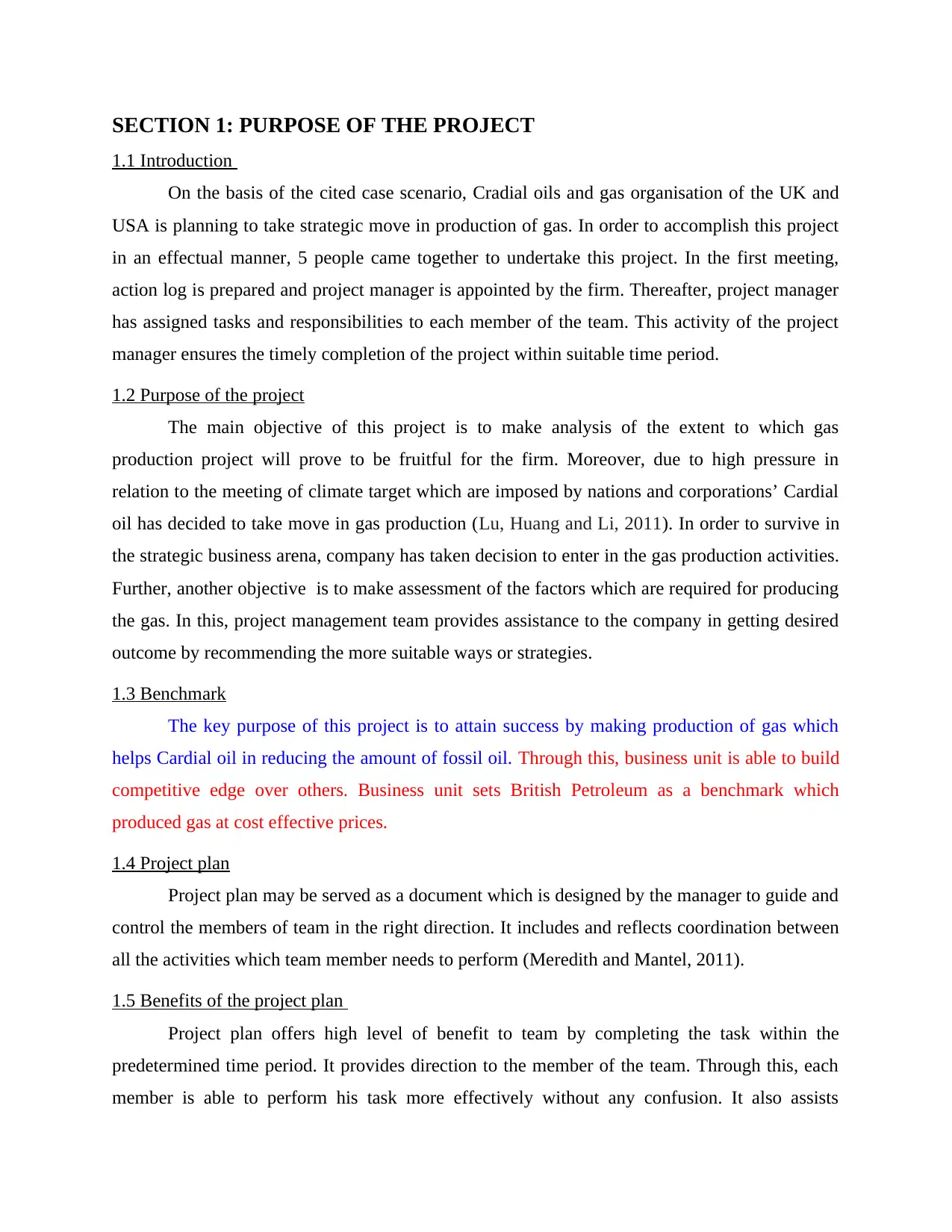
SECTION 1: PURPOSE OF THE PROJECT
1.1 Introduction
On the basis of the cited case scenario, Cradial oils and gas organisation of the UK and
USA is planning to take strategic move in production of gas. In order to accomplish this project
in an effectual manner, 5 people came together to undertake this project. In the first meeting,
action log is prepared and project manager is appointed by the firm. Thereafter, project manager
has assigned tasks and responsibilities to each member of the team. This activity of the project
manager ensures the timely completion of the project within suitable time period.
1.2 Purpose of the project
The main objective of this project is to make analysis of the extent to which gas
production project will prove to be fruitful for the firm. Moreover, due to high pressure in
relation to the meeting of climate target which are imposed by nations and corporations’ Cardial
oil has decided to take move in gas production (Lu, Huang and Li, 2011). In order to survive in
the strategic business arena, company has taken decision to enter in the gas production activities.
Further, another objective is to make assessment of the factors which are required for producing
the gas. In this, project management team provides assistance to the company in getting desired
outcome by recommending the more suitable ways or strategies.
1.3 Benchmark
The key purpose of this project is to attain success by making production of gas which
helps Cardial oil in reducing the amount of fossil oil. Through this, business unit is able to build
competitive edge over others. Business unit sets British Petroleum as a benchmark which
produced gas at cost effective prices.
1.4 Project plan
Project plan may be served as a document which is designed by the manager to guide and
control the members of team in the right direction. It includes and reflects coordination between
all the activities which team member needs to perform (Meredith and Mantel, 2011).
1.5 Benefits of the project plan
Project plan offers high level of benefit to team by completing the task within the
predetermined time period. It provides direction to the member of the team. Through this, each
member is able to perform his task more effectively without any confusion. It also assists
1.1 Introduction
On the basis of the cited case scenario, Cradial oils and gas organisation of the UK and
USA is planning to take strategic move in production of gas. In order to accomplish this project
in an effectual manner, 5 people came together to undertake this project. In the first meeting,
action log is prepared and project manager is appointed by the firm. Thereafter, project manager
has assigned tasks and responsibilities to each member of the team. This activity of the project
manager ensures the timely completion of the project within suitable time period.
1.2 Purpose of the project
The main objective of this project is to make analysis of the extent to which gas
production project will prove to be fruitful for the firm. Moreover, due to high pressure in
relation to the meeting of climate target which are imposed by nations and corporations’ Cardial
oil has decided to take move in gas production (Lu, Huang and Li, 2011). In order to survive in
the strategic business arena, company has taken decision to enter in the gas production activities.
Further, another objective is to make assessment of the factors which are required for producing
the gas. In this, project management team provides assistance to the company in getting desired
outcome by recommending the more suitable ways or strategies.
1.3 Benchmark
The key purpose of this project is to attain success by making production of gas which
helps Cardial oil in reducing the amount of fossil oil. Through this, business unit is able to build
competitive edge over others. Business unit sets British Petroleum as a benchmark which
produced gas at cost effective prices.
1.4 Project plan
Project plan may be served as a document which is designed by the manager to guide and
control the members of team in the right direction. It includes and reflects coordination between
all the activities which team member needs to perform (Meredith and Mantel, 2011).
1.5 Benefits of the project plan
Project plan offers high level of benefit to team by completing the task within the
predetermined time period. It provides direction to the member of the team. Through this, each
member is able to perform his task more effectively without any confusion. It also assists
Paraphrase This Document
Need a fresh take? Get an instant paraphrase of this document with our AI Paraphraser
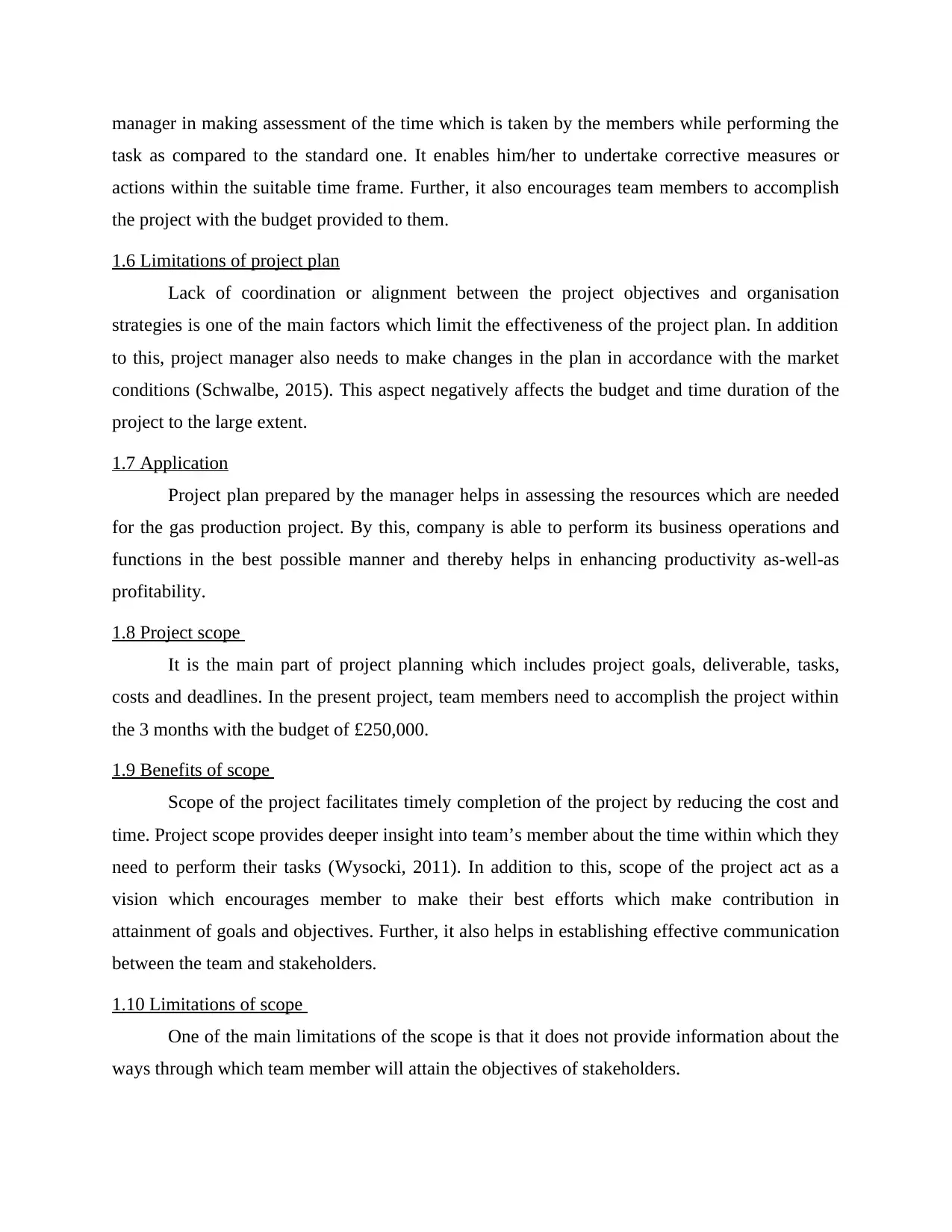
manager in making assessment of the time which is taken by the members while performing the
task as compared to the standard one. It enables him/her to undertake corrective measures or
actions within the suitable time frame. Further, it also encourages team members to accomplish
the project with the budget provided to them.
1.6 Limitations of project plan
Lack of coordination or alignment between the project objectives and organisation
strategies is one of the main factors which limit the effectiveness of the project plan. In addition
to this, project manager also needs to make changes in the plan in accordance with the market
conditions (Schwalbe, 2015). This aspect negatively affects the budget and time duration of the
project to the large extent.
1.7 Application
Project plan prepared by the manager helps in assessing the resources which are needed
for the gas production project. By this, company is able to perform its business operations and
functions in the best possible manner and thereby helps in enhancing productivity as-well-as
profitability.
1.8 Project scope
It is the main part of project planning which includes project goals, deliverable, tasks,
costs and deadlines. In the present project, team members need to accomplish the project within
the 3 months with the budget of £250,000.
1.9 Benefits of scope
Scope of the project facilitates timely completion of the project by reducing the cost and
time. Project scope provides deeper insight into team’s member about the time within which they
need to perform their tasks (Wysocki, 2011). In addition to this, scope of the project act as a
vision which encourages member to make their best efforts which make contribution in
attainment of goals and objectives. Further, it also helps in establishing effective communication
between the team and stakeholders.
1.10 Limitations of scope
One of the main limitations of the scope is that it does not provide information about the
ways through which team member will attain the objectives of stakeholders.
task as compared to the standard one. It enables him/her to undertake corrective measures or
actions within the suitable time frame. Further, it also encourages team members to accomplish
the project with the budget provided to them.
1.6 Limitations of project plan
Lack of coordination or alignment between the project objectives and organisation
strategies is one of the main factors which limit the effectiveness of the project plan. In addition
to this, project manager also needs to make changes in the plan in accordance with the market
conditions (Schwalbe, 2015). This aspect negatively affects the budget and time duration of the
project to the large extent.
1.7 Application
Project plan prepared by the manager helps in assessing the resources which are needed
for the gas production project. By this, company is able to perform its business operations and
functions in the best possible manner and thereby helps in enhancing productivity as-well-as
profitability.
1.8 Project scope
It is the main part of project planning which includes project goals, deliverable, tasks,
costs and deadlines. In the present project, team members need to accomplish the project within
the 3 months with the budget of £250,000.
1.9 Benefits of scope
Scope of the project facilitates timely completion of the project by reducing the cost and
time. Project scope provides deeper insight into team’s member about the time within which they
need to perform their tasks (Wysocki, 2011). In addition to this, scope of the project act as a
vision which encourages member to make their best efforts which make contribution in
attainment of goals and objectives. Further, it also helps in establishing effective communication
between the team and stakeholders.
1.10 Limitations of scope
One of the main limitations of the scope is that it does not provide information about the
ways through which team member will attain the objectives of stakeholders.
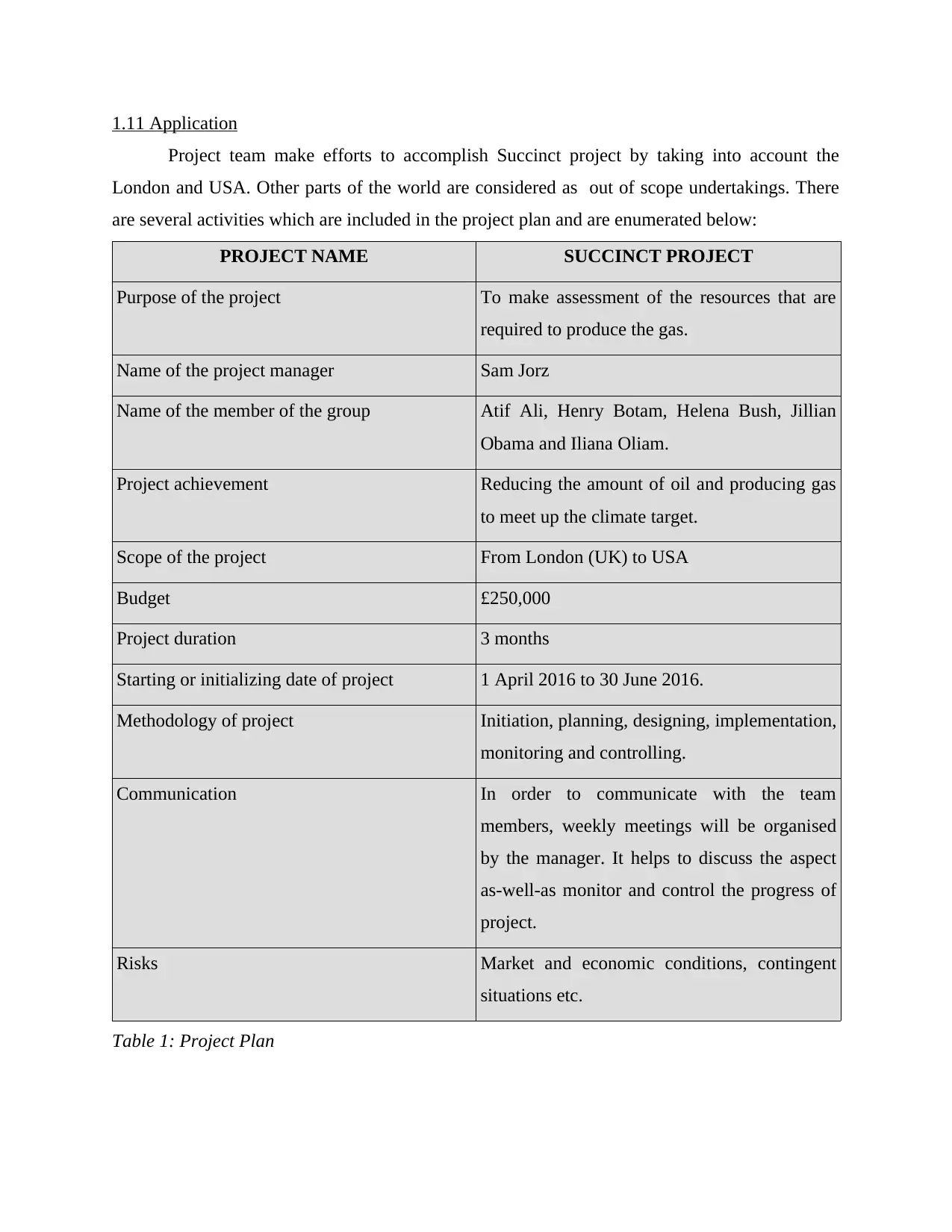
1.11 Application
Project team make efforts to accomplish Succinct project by taking into account the
London and USA. Other parts of the world are considered as out of scope undertakings. There
are several activities which are included in the project plan and are enumerated below:
PROJECT NAME SUCCINCT PROJECT
Purpose of the project To make assessment of the resources that are
required to produce the gas.
Name of the project manager Sam Jorz
Name of the member of the group Atif Ali, Henry Botam, Helena Bush, Jillian
Obama and Iliana Oliam.
Project achievement Reducing the amount of oil and producing gas
to meet up the climate target.
Scope of the project From London (UK) to USA
Budget £250,000
Project duration 3 months
Starting or initializing date of project 1 April 2016 to 30 June 2016.
Methodology of project Initiation, planning, designing, implementation,
monitoring and controlling.
Communication In order to communicate with the team
members, weekly meetings will be organised
by the manager. It helps to discuss the aspect
as-well-as monitor and control the progress of
project.
Risks Market and economic conditions, contingent
situations etc.
Table 1: Project Plan
Project team make efforts to accomplish Succinct project by taking into account the
London and USA. Other parts of the world are considered as out of scope undertakings. There
are several activities which are included in the project plan and are enumerated below:
PROJECT NAME SUCCINCT PROJECT
Purpose of the project To make assessment of the resources that are
required to produce the gas.
Name of the project manager Sam Jorz
Name of the member of the group Atif Ali, Henry Botam, Helena Bush, Jillian
Obama and Iliana Oliam.
Project achievement Reducing the amount of oil and producing gas
to meet up the climate target.
Scope of the project From London (UK) to USA
Budget £250,000
Project duration 3 months
Starting or initializing date of project 1 April 2016 to 30 June 2016.
Methodology of project Initiation, planning, designing, implementation,
monitoring and controlling.
Communication In order to communicate with the team
members, weekly meetings will be organised
by the manager. It helps to discuss the aspect
as-well-as monitor and control the progress of
project.
Risks Market and economic conditions, contingent
situations etc.
Table 1: Project Plan
⊘ This is a preview!⊘
Do you want full access?
Subscribe today to unlock all pages.

Trusted by 1+ million students worldwide
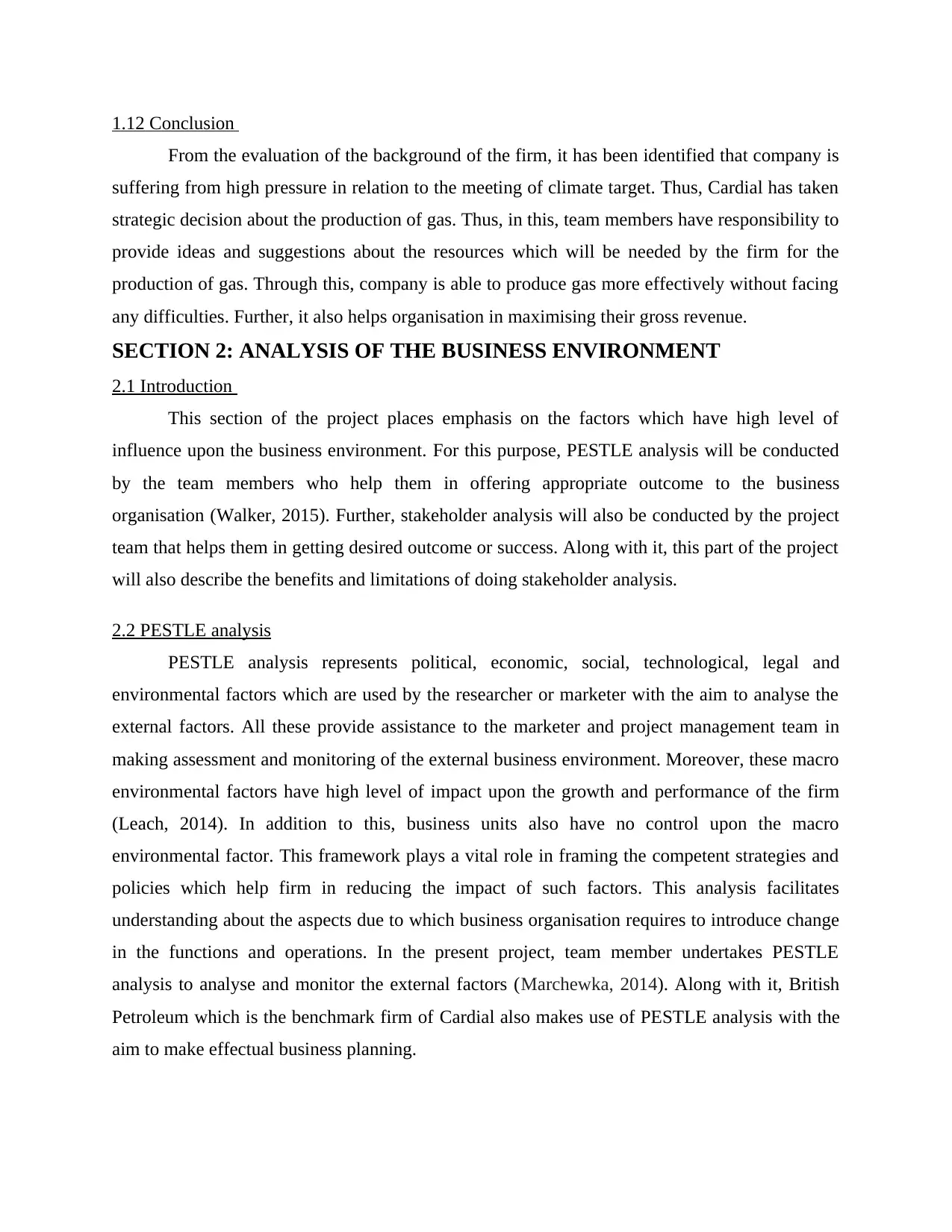
1.12 Conclusion
From the evaluation of the background of the firm, it has been identified that company is
suffering from high pressure in relation to the meeting of climate target. Thus, Cardial has taken
strategic decision about the production of gas. Thus, in this, team members have responsibility to
provide ideas and suggestions about the resources which will be needed by the firm for the
production of gas. Through this, company is able to produce gas more effectively without facing
any difficulties. Further, it also helps organisation in maximising their gross revenue.
SECTION 2: ANALYSIS OF THE BUSINESS ENVIRONMENT
2.1 Introduction
This section of the project places emphasis on the factors which have high level of
influence upon the business environment. For this purpose, PESTLE analysis will be conducted
by the team members who help them in offering appropriate outcome to the business
organisation (Walker, 2015). Further, stakeholder analysis will also be conducted by the project
team that helps them in getting desired outcome or success. Along with it, this part of the project
will also describe the benefits and limitations of doing stakeholder analysis.
2.2 PESTLE analysis
PESTLE analysis represents political, economic, social, technological, legal and
environmental factors which are used by the researcher or marketer with the aim to analyse the
external factors. All these provide assistance to the marketer and project management team in
making assessment and monitoring of the external business environment. Moreover, these macro
environmental factors have high level of impact upon the growth and performance of the firm
(Leach, 2014). In addition to this, business units also have no control upon the macro
environmental factor. This framework plays a vital role in framing the competent strategies and
policies which help firm in reducing the impact of such factors. This analysis facilitates
understanding about the aspects due to which business organisation requires to introduce change
in the functions and operations. In the present project, team member undertakes PESTLE
analysis to analyse and monitor the external factors (Marchewka, 2014). Along with it, British
Petroleum which is the benchmark firm of Cardial also makes use of PESTLE analysis with the
aim to make effectual business planning.
From the evaluation of the background of the firm, it has been identified that company is
suffering from high pressure in relation to the meeting of climate target. Thus, Cardial has taken
strategic decision about the production of gas. Thus, in this, team members have responsibility to
provide ideas and suggestions about the resources which will be needed by the firm for the
production of gas. Through this, company is able to produce gas more effectively without facing
any difficulties. Further, it also helps organisation in maximising their gross revenue.
SECTION 2: ANALYSIS OF THE BUSINESS ENVIRONMENT
2.1 Introduction
This section of the project places emphasis on the factors which have high level of
influence upon the business environment. For this purpose, PESTLE analysis will be conducted
by the team members who help them in offering appropriate outcome to the business
organisation (Walker, 2015). Further, stakeholder analysis will also be conducted by the project
team that helps them in getting desired outcome or success. Along with it, this part of the project
will also describe the benefits and limitations of doing stakeholder analysis.
2.2 PESTLE analysis
PESTLE analysis represents political, economic, social, technological, legal and
environmental factors which are used by the researcher or marketer with the aim to analyse the
external factors. All these provide assistance to the marketer and project management team in
making assessment and monitoring of the external business environment. Moreover, these macro
environmental factors have high level of impact upon the growth and performance of the firm
(Leach, 2014). In addition to this, business units also have no control upon the macro
environmental factor. This framework plays a vital role in framing the competent strategies and
policies which help firm in reducing the impact of such factors. This analysis facilitates
understanding about the aspects due to which business organisation requires to introduce change
in the functions and operations. In the present project, team member undertakes PESTLE
analysis to analyse and monitor the external factors (Marchewka, 2014). Along with it, British
Petroleum which is the benchmark firm of Cardial also makes use of PESTLE analysis with the
aim to make effectual business planning.
Paraphrase This Document
Need a fresh take? Get an instant paraphrase of this document with our AI Paraphraser
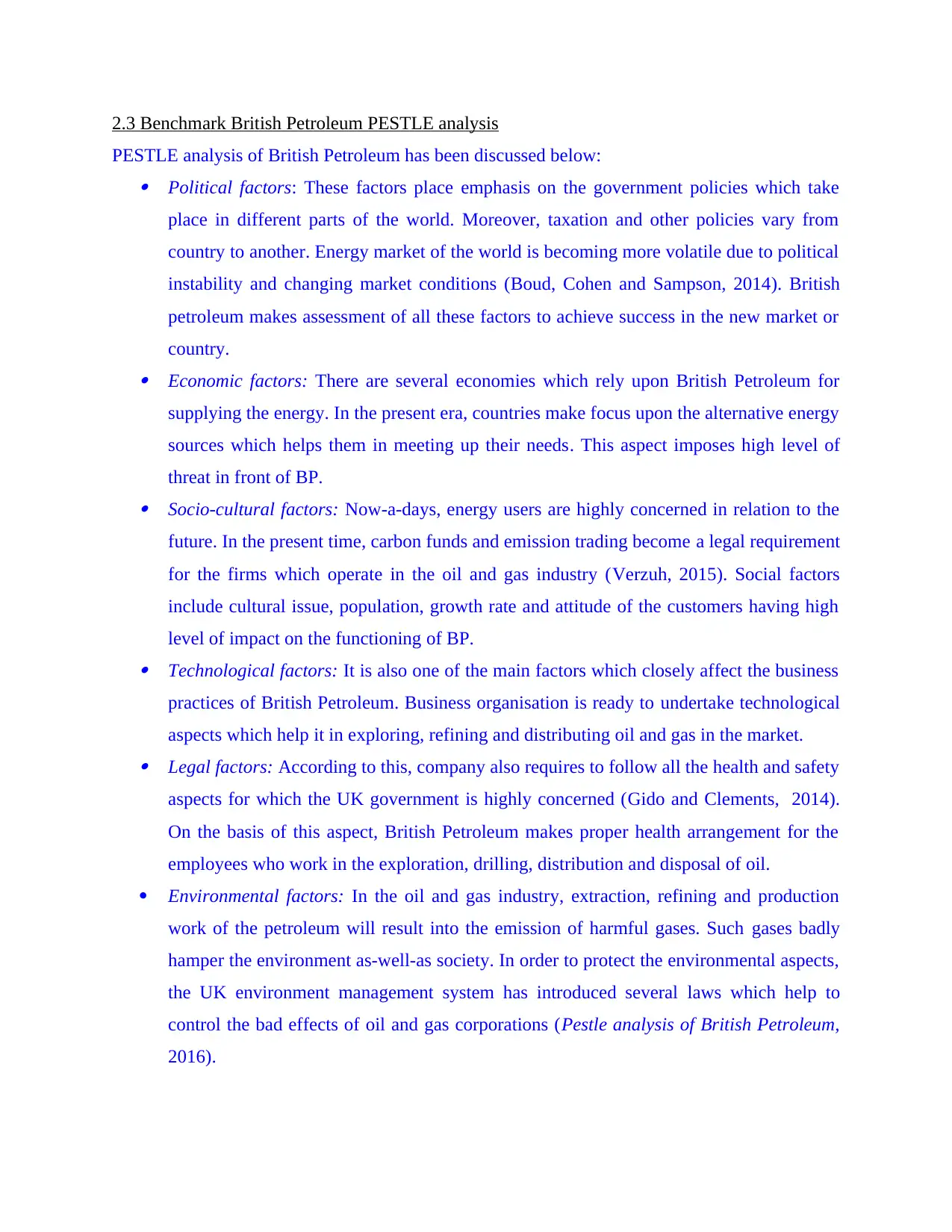
2.3 Benchmark British Petroleum PESTLE analysis
PESTLE analysis of British Petroleum has been discussed below: Political factors: These factors place emphasis on the government policies which take
place in different parts of the world. Moreover, taxation and other policies vary from
country to another. Energy market of the world is becoming more volatile due to political
instability and changing market conditions (Boud, Cohen and Sampson, 2014). British
petroleum makes assessment of all these factors to achieve success in the new market or
country. Economic factors: There are several economies which rely upon British Petroleum for
supplying the energy. In the present era, countries make focus upon the alternative energy
sources which helps them in meeting up their needs. This aspect imposes high level of
threat in front of BP. Socio-cultural factors: Now-a-days, energy users are highly concerned in relation to the
future. In the present time, carbon funds and emission trading become a legal requirement
for the firms which operate in the oil and gas industry (Verzuh, 2015). Social factors
include cultural issue, population, growth rate and attitude of the customers having high
level of impact on the functioning of BP. Technological factors: It is also one of the main factors which closely affect the business
practices of British Petroleum. Business organisation is ready to undertake technological
aspects which help it in exploring, refining and distributing oil and gas in the market. Legal factors: According to this, company also requires to follow all the health and safety
aspects for which the UK government is highly concerned (Gido and Clements, 2014).
On the basis of this aspect, British Petroleum makes proper health arrangement for the
employees who work in the exploration, drilling, distribution and disposal of oil.
Environmental factors: In the oil and gas industry, extraction, refining and production
work of the petroleum will result into the emission of harmful gases. Such gases badly
hamper the environment as-well-as society. In order to protect the environmental aspects,
the UK environment management system has introduced several laws which help to
control the bad effects of oil and gas corporations (Pestle analysis of British Petroleum,
2016).
PESTLE analysis of British Petroleum has been discussed below: Political factors: These factors place emphasis on the government policies which take
place in different parts of the world. Moreover, taxation and other policies vary from
country to another. Energy market of the world is becoming more volatile due to political
instability and changing market conditions (Boud, Cohen and Sampson, 2014). British
petroleum makes assessment of all these factors to achieve success in the new market or
country. Economic factors: There are several economies which rely upon British Petroleum for
supplying the energy. In the present era, countries make focus upon the alternative energy
sources which helps them in meeting up their needs. This aspect imposes high level of
threat in front of BP. Socio-cultural factors: Now-a-days, energy users are highly concerned in relation to the
future. In the present time, carbon funds and emission trading become a legal requirement
for the firms which operate in the oil and gas industry (Verzuh, 2015). Social factors
include cultural issue, population, growth rate and attitude of the customers having high
level of impact on the functioning of BP. Technological factors: It is also one of the main factors which closely affect the business
practices of British Petroleum. Business organisation is ready to undertake technological
aspects which help it in exploring, refining and distributing oil and gas in the market. Legal factors: According to this, company also requires to follow all the health and safety
aspects for which the UK government is highly concerned (Gido and Clements, 2014).
On the basis of this aspect, British Petroleum makes proper health arrangement for the
employees who work in the exploration, drilling, distribution and disposal of oil.
Environmental factors: In the oil and gas industry, extraction, refining and production
work of the petroleum will result into the emission of harmful gases. Such gases badly
hamper the environment as-well-as society. In order to protect the environmental aspects,
the UK environment management system has introduced several laws which help to
control the bad effects of oil and gas corporations (Pestle analysis of British Petroleum,
2016).
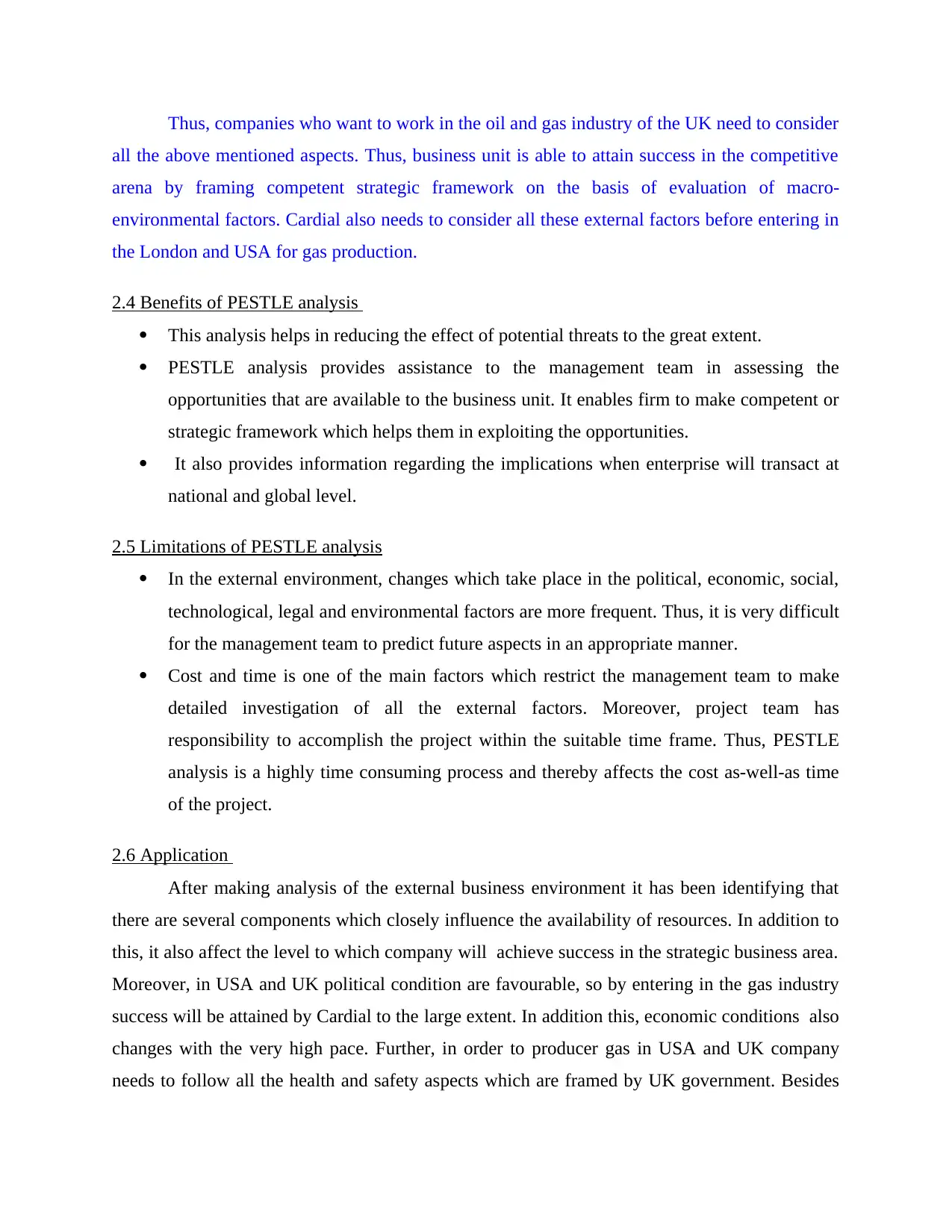
Thus, companies who want to work in the oil and gas industry of the UK need to consider
all the above mentioned aspects. Thus, business unit is able to attain success in the competitive
arena by framing competent strategic framework on the basis of evaluation of macro-
environmental factors. Cardial also needs to consider all these external factors before entering in
the London and USA for gas production.
2.4 Benefits of PESTLE analysis
This analysis helps in reducing the effect of potential threats to the great extent.
PESTLE analysis provides assistance to the management team in assessing the
opportunities that are available to the business unit. It enables firm to make competent or
strategic framework which helps them in exploiting the opportunities.
It also provides information regarding the implications when enterprise will transact at
national and global level.
2.5 Limitations of PESTLE analysis
In the external environment, changes which take place in the political, economic, social,
technological, legal and environmental factors are more frequent. Thus, it is very difficult
for the management team to predict future aspects in an appropriate manner.
Cost and time is one of the main factors which restrict the management team to make
detailed investigation of all the external factors. Moreover, project team has
responsibility to accomplish the project within the suitable time frame. Thus, PESTLE
analysis is a highly time consuming process and thereby affects the cost as-well-as time
of the project.
2.6 Application
After making analysis of the external business environment it has been identifying that
there are several components which closely influence the availability of resources. In addition to
this, it also affect the level to which company will achieve success in the strategic business area.
Moreover, in USA and UK political condition are favourable, so by entering in the gas industry
success will be attained by Cardial to the large extent. In addition this, economic conditions also
changes with the very high pace. Further, in order to producer gas in USA and UK company
needs to follow all the health and safety aspects which are framed by UK government. Besides
all the above mentioned aspects. Thus, business unit is able to attain success in the competitive
arena by framing competent strategic framework on the basis of evaluation of macro-
environmental factors. Cardial also needs to consider all these external factors before entering in
the London and USA for gas production.
2.4 Benefits of PESTLE analysis
This analysis helps in reducing the effect of potential threats to the great extent.
PESTLE analysis provides assistance to the management team in assessing the
opportunities that are available to the business unit. It enables firm to make competent or
strategic framework which helps them in exploiting the opportunities.
It also provides information regarding the implications when enterprise will transact at
national and global level.
2.5 Limitations of PESTLE analysis
In the external environment, changes which take place in the political, economic, social,
technological, legal and environmental factors are more frequent. Thus, it is very difficult
for the management team to predict future aspects in an appropriate manner.
Cost and time is one of the main factors which restrict the management team to make
detailed investigation of all the external factors. Moreover, project team has
responsibility to accomplish the project within the suitable time frame. Thus, PESTLE
analysis is a highly time consuming process and thereby affects the cost as-well-as time
of the project.
2.6 Application
After making analysis of the external business environment it has been identifying that
there are several components which closely influence the availability of resources. In addition to
this, it also affect the level to which company will achieve success in the strategic business area.
Moreover, in USA and UK political condition are favourable, so by entering in the gas industry
success will be attained by Cardial to the large extent. In addition this, economic conditions also
changes with the very high pace. Further, in order to producer gas in USA and UK company
needs to follow all the health and safety aspects which are framed by UK government. Besides
⊘ This is a preview!⊘
Do you want full access?
Subscribe today to unlock all pages.

Trusted by 1+ million students worldwide
1 out of 29
Related Documents
Your All-in-One AI-Powered Toolkit for Academic Success.
+13062052269
info@desklib.com
Available 24*7 on WhatsApp / Email
![[object Object]](/_next/static/media/star-bottom.7253800d.svg)
Unlock your academic potential
Copyright © 2020–2025 A2Z Services. All Rights Reserved. Developed and managed by ZUCOL.

